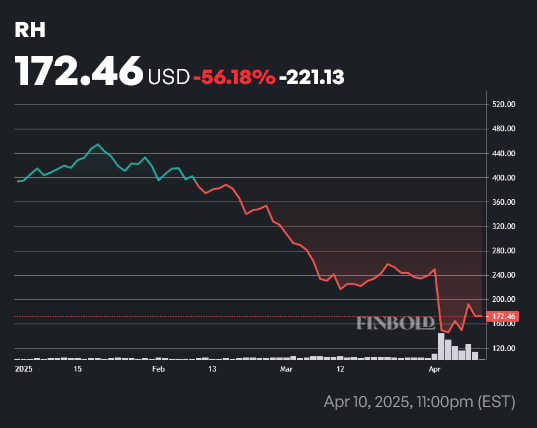Marjorie Taylor Greene has long been considered one of the worst stock traders on Capitol Hill. A change in administration seems to have brought a change in her fortunes as well.
Following the market-wide dip that ensued after the April 2 tariffs, Finbold’s congressional trading radar picked up on a number of trades made by the Georgia congresswoman.
Receive Signals on US Congress Members' Stock Trades
Stay up-to-date on the trading activity of US Congress members. The signal triggers based on updates from the House disclosure reports, notifying you of their latest stock transactions.
The representative’s trades were quite suspicious — to use the most obvious example, her bet on discount retailer Dollar General (NYSE: DG) soared by 29% in a matter of days following the tariff announcement.
However, there’s one trade that stands apart from all the rest — Marjorie Taylor Greene’s sudden purchase of RH stock (NYSE: RH). Let us explain why this perfectly-timed tariff trade is the most suspicious one that MTG has made.
How did Marjorie Taylor Greene buy the bottom of this struggling stock?
We need to take a look at the bigger picture to get a sense of the congresswoman’s suddenly impeccable timing.
This is what the year-to-date (YTD) price chart of RH stock looks like.

The lowest point on this chart, when RH shares were changing hands at prices ranging from $123 to $154, was April 4. For the sake of simplicity, we’ll be using the stock’s price at close, $145.66.
That happens to be exactly the day that MTG bought RH stock — by press time, RH stock has seen prices increase to $172.46, and the representative’s investment has already netted her an 18.39% profit. Depending on how well she timed her trade, her return could be as high as 40.2%. The trade was even more profitable at yesterday’s $193.82 high — at which point the profit from a hypothetical sale would have been between 33.06% and 57.57%.
All in all, Marjorie Taylor Greene managed to almost perfectly catch a double-digit upswing in the price of a stock that is, even with the recent surge accounted for, down 56.18% since the start of the year.
Featured image via Shutterstock







